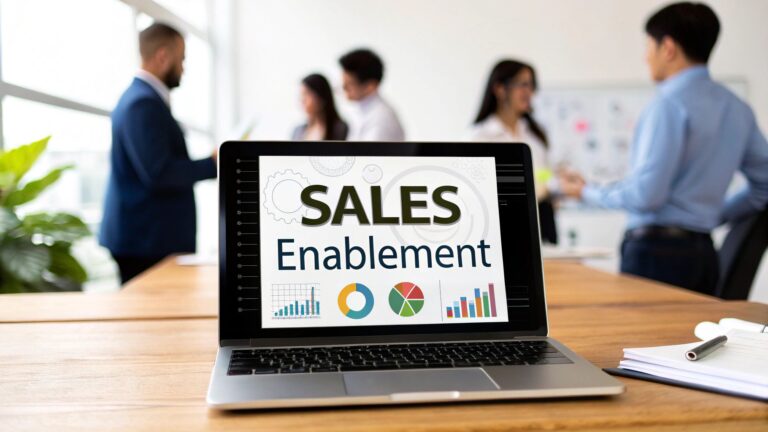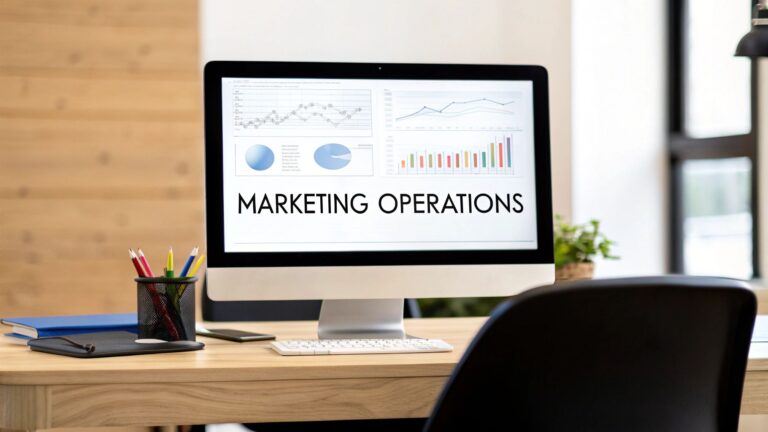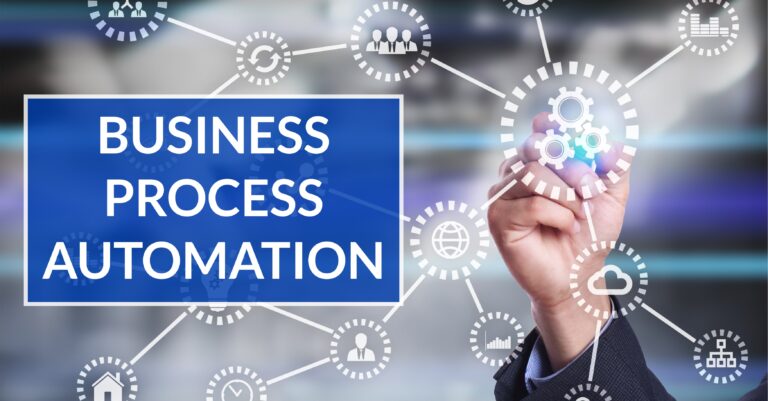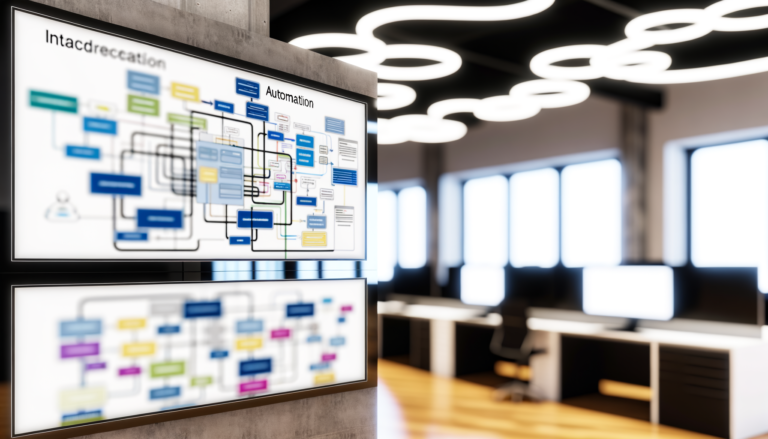How to Automate Lead Generation and Boost Your Sales
Automating your lead generation is like building a machine that finds, qualifies, and nurtures potential customers for you, even while you sleep. It’s a system that uses software to capture interest—say, from a form on your website—and then automatically guides those people through your sales process with relevant, personalized messages. The real beauty of this is that it frees up your sales team to do what they do best: have meaningful conversations with people who are actually ready to buy.
Why Automated Lead Generation Is Your New Sales Engine
Let’s be honest, manual lead generation is a soul-crushing grind. It’s an endless loop of data entry, cold emails, and chasing down prospects who often aren’t a great fit anyway. That old-school approach doesn’t just drain your team’s time and energy; it completely throttles your ability to grow. Your pipeline is literally capped by the number of hours your team can put in.
Automation flips that entire model on its head. Instead of a system that depends on sheer effort, you build a self-sustaining engine that works for you 24/7. Think of it as the difference between digging a well with a shovel and building an aqueduct that delivers a constant, reliable flow of water. This engine ensures no lead ever slips through the cracks and every single prospect gets a timely, relevant touchpoint.
The Strategic Value of Automation
The true power here isn't just about saving time—it’s about fundamentally creating a smarter, more effective sales process. An automated system lets your sales reps stop prospecting and start selling. They can finally shift their energy from tedious, low-impact tasks to having strategic conversations with prospects who have already been warmed up and qualified by the system.
This shift brings some massive advantages to the table:
- Scalable Growth: Your automated engine can handle a virtually unlimited number of leads without needing more people on payroll. As your marketing campaigns bring in more traffic, the system just keeps on processing and nurturing them.
- Improved Data Accuracy: Automation puts an end to costly manual data entry mistakes. When someone fills out a form, their information flows directly and accurately into your CRM. This gives you clean, reliable data you can actually trust for personalization and reporting.
- Consistent Lead Flow: Say goodbye to the frustrating "feast or famine" cycle that plagues so many sales teams. Automation provides a predictable stream of prospects, which makes revenue forecasting more accurate and business planning a whole lot less stressful.
To truly grasp how this works, it helps to break down the core pillars of any effective automated lead generation system. These components work together to create a seamless journey for your prospects.
Core Components of an Automated Lead Generation System
| Component | Function | Key Benefit |
|---|---|---|
| Lead Capture | Gathers prospect information through forms, pop-ups, and landing pages. | Creates the initial entry point for prospects into your funnel. |
| CRM System | Acts as the central database for all lead and customer information. | Provides a single source of truth for tracking interactions and data. |
| Marketing Automation | Triggers automated email sequences and workflows based on lead behavior. | Nurtures leads with personalized content at the right time, without manual effort. |
| Lead Scoring | Ranks leads based on their profile and engagement level. | Helps sales prioritize their time on the most promising opportunities. |
| Analytics & Reporting | Tracks performance metrics to measure what’s working and what isn’t. | Offers the insights needed to continuously optimize the entire system. |
Each of these pieces is crucial. Without a way to capture leads, the system has no fuel. Without a CRM, the data is chaos. And without automation and analytics, you can't scale or improve.
The Compelling Economics of Automation
The numbers don’t lie. For 2025, lead generation remains a top priority for half of all marketers, and the average company is trying to pull in nearly 1,900 leads every single month. The problem? The average cost per lead is a hefty $198, and a staggering 97% of people ignore cold calls. Relying on old methods is not just inefficient—it’s becoming a financial dead end.
You can dive deeper into these figures with these lead generation statistics at ExplodingTopics.com. Automation is the clear solution to this puzzle, boosting efficiency and giving your ROI a serious lift.
By automating the top of your funnel, you're not just creating efficiency; you are building a valuable business asset. This engine becomes a predictable source of revenue that compounds over time.
Ultimately, learning how to automate lead generation is about more than just picking the right tools. It’s a strategic decision to build a more resilient, scalable, and profitable business for the long haul.
Building Your Automated Lead Capture Funnel

This is where the rubber meets the road. Your entire automation strategy hinges on one critical element: effective lead capture. After all, if you don't have a steady stream of new prospects coming in, there's nothing to nurture or sell to.
But let’s be honest, just sticking a "Contact Us" form on your website and hoping for the best isn't going to cut it anymore. To build a system that genuinely works for you 24/7, you need to create entry points that your ideal customers actually want to engage with. It's about shifting from passive data collection to an active exchange of value.
Designing High-Converting Lead Magnets
Think of a lead magnet as your opening offer—the valuable resource you provide in exchange for someone's contact details. The quality of this offer is directly tied to your conversion rates. Before you even think about building, the first step is always identifying your ideal target audience. When you know exactly who you're talking to, you can craft an offer they can't possibly ignore.
Of course, the right lead magnet depends entirely on your business model. The trick is to align the offer with your audience's immediate needs and your own business goals.
Here are a few real-world examples I've seen work wonders:
- For a SaaS Company: A free, feature-limited version of your software or a niche calculator (like an ROI calculator) is a fantastic way to go. It gives potential customers a real taste of your product's power.
- For a B2B Consultancy: Think about what proves your expertise. A detailed whitepaper, an exclusive case study, or a pre-recorded webinar on a specific industry pain point will attract serious decision-makers.
- For an Ecommerce Brand: You can't go wrong with a classic "15% off your first order" coupon. A curated style guide or early access to a new product drop also works incredibly well to capture emails from eager shoppers.
The point is to provide instant, real value. A weak offer will only attract low-quality leads, but a strong one brings in prospects who are already looking for the solution you provide.
The best lead magnets solve a small, specific problem for your audience, giving them a quick win and building instant trust in your brand's ability to deliver results.
Moving Beyond Static Forms
Yes, you need a form, but how you present it changes everything. It's time to ditch the bland, generic fields and start using interactive and context-aware capture methods.
Interactive quizzes are a perfect example. Instead of just demanding an email, you pull the user in with a series of questions. A marketing agency could create a "What's Your Digital Marketing Score?" quiz. This not only provides genuine value to the user but also gathers crucial qualification data for the agency. Based on their answers, you can automatically drop them into different, highly relevant follow-up sequences.
Webinar sign-ups are another goldmine. They attract a dedicated audience ready to give you an hour of their time to learn. Automating the registration, reminders, and follow-up emails is a foundational part of any successful lead generation system.
The Anatomy of a Landing Page That Converts
Your lead magnet deserves its own dedicated stage—a landing page with one goal and one goal only: get the conversion. A cluttered homepage with competing messages will kill your capture rate. An effective landing page is laser-focused and persuasive.
Here’s what every high-converting landing page needs:
- A Killer Headline: It must instantly scream "this is valuable" and communicate the benefit of your offer.
- Benefit-Driven Copy: Forget features; focus on what the prospect gets. Use bullet points to make the benefits easy to scan and digest.
- Social Proof: Nothing builds trust faster. Add testimonials, logos of past clients, or stats like "Join 10,000+ marketers…" to show you're the real deal.
- A Single, Unmistakable Call-to-Action (CTA): One button. One desired action. That's it. Remove all other navigation links that could distract them.
- A Simple Form: Only ask for what you absolutely need. Remember, every extra field you add can slash conversions by up to 11%.
Once you've captured that lead, the journey isn't over. The next logical step is to guide them toward a sale. This is the perfect time to explore automated email marketing campaigns that deliver personalized content based on the very lead magnet they downloaded. This seamless handoff from capture to nurture is the true sign of a well-oiled automation machine.
Choosing Your Automation Tech Stack
Now that you have a solid strategy for capturing leads, it's time to pick the tools that will do the heavy lifting. Your tech stack is more than just a random collection of software; it's the engine that will power your entire automated lead generation machine. Getting this right from the start is critical because the tools you select will define your capabilities, your potential for growth, and your overall efficiency.
The goal isn't to chase some mythical "all-in-one" solution that does everything perfectly. Instead, think of it like building a custom PC. You need a powerful motherboard (your CRM), a high-end graphics card (your email marketing platform), and quality peripherals (your lead capture tools). For peak performance, every component has to talk to the others flawlessly.
The Three Pillars of Your Tech Stack
From my experience, most successful automated lead generation systems are built on three foundational types of tools. Even if you opt for a platform that claims to do it all, understanding what each component should do helps you make a smarter choice.
Here's the essential trio:
-
Customer Relationship Management (CRM): This is mission control. Your CRM acts as the central brain, storing every piece of lead data, tracking every interaction, and serving as the single source of truth. It's where you'll do your lead scoring and where your sales team will live and breathe.
-
Email & Marketing Automation Platform: This is your nurturing workhorse. This tool is responsible for sending the right message at the right time, whether it's an automated welcome sequence or a complex, behavior-driven campaign. It executes the workflows you design to guide leads down the funnel.
-
Lead Capture Tools: These are your front-line soldiers. I'm talking about advanced form builders, smart pop-ups, interactive quiz software, and high-converting landing page builders. Their entire purpose is to grab a visitor's attention and convert them into a lead.
The best stacks often look like a carefully curated dashboard of different apps, each excelling at its specific job.
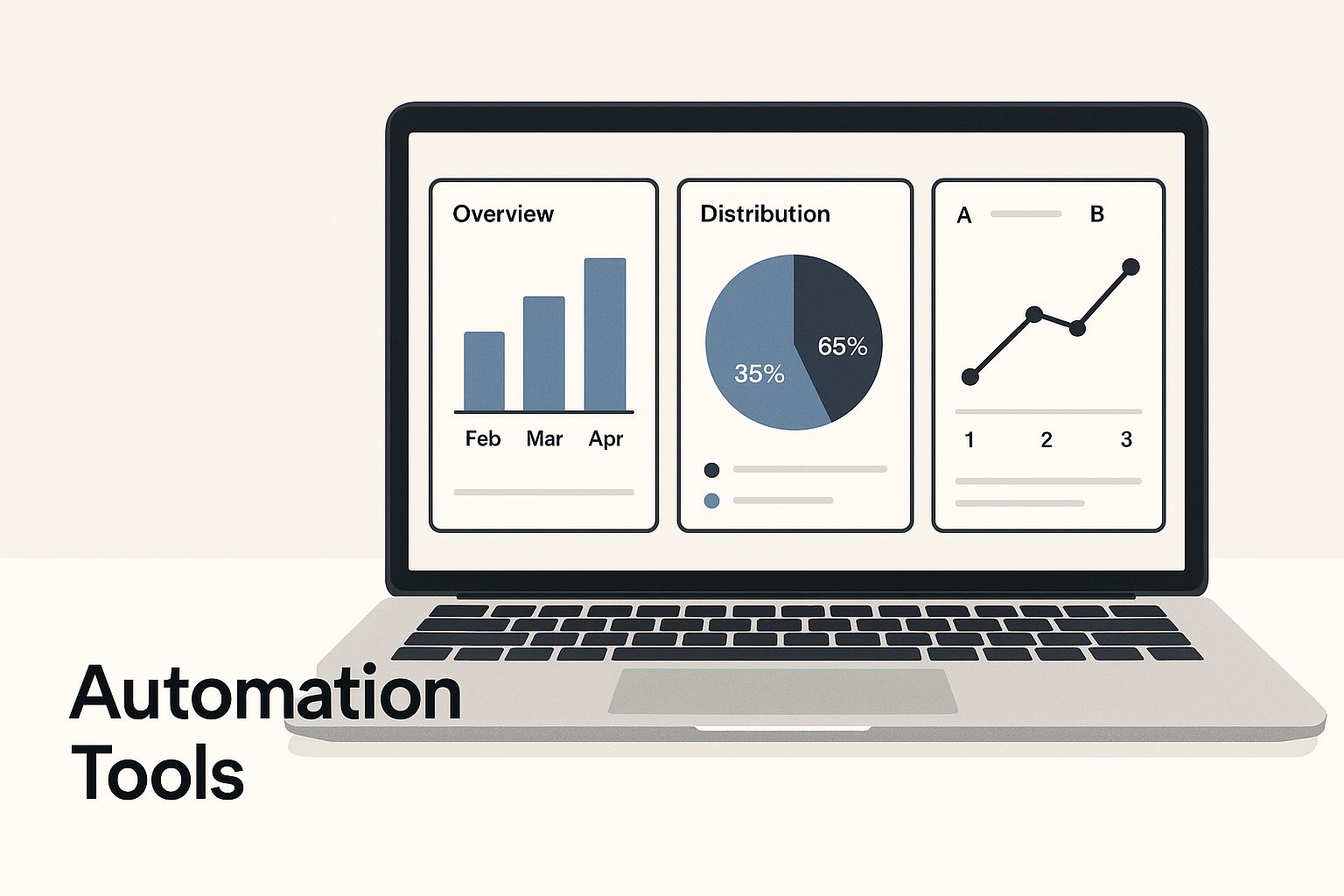
This setup shows how different, specialized tools can work in concert to create a complete lead generation and management system.
To help you navigate the options, let's look at the main categories of automation software you'll encounter.
Comparing Popular Lead Automation Tool Categories
| Tool Category | Primary Function | Examples | Best For |
|---|---|---|---|
| All-in-One CRMs | Centralized marketing, sales, and service | HubSpot, Pardot (Salesforce) | Businesses seeking a single, unified platform and data source. |
| Email Automation | Nurturing sequences, broadcasts, segmentation | Mailchimp, ActiveCampaign | Companies focused on sophisticated email marketing and follow-up. |
| Lead Capture | Forms, pop-ups, quizzes, landing pages | OptinMonster, Leadpages | Marketers who need to maximize top-of-funnel conversion rates. |
| Integration Platforms | Connecting disparate apps and workflows | Zapier, Make | Teams with specialized tools that lack native integrations. |
Ultimately, you'll need to decide whether to go with an integrated suite like HubSpot, which simplifies things, or a "best-of-breed" approach where you handpick specialized tools and connect them.
How To Evaluate And Select Your Tools
The sheer number of software options can be paralyzing. To cut through the noise, I recommend focusing on three practical criteria: integration, scalability, and features. Don't get distracted by shiny objects you'll never use.
First, integration is non-negotiable. If your form builder can't instantly send data to your CRM, and your CRM can't trigger an email sequence, you don't have automation—you have a glorified spreadsheet and a ton of manual work. Look for native integrations first, but robust support for connectors like Zapier is a great fallback.
Second, think about scalability. The tool that works beautifully for 100 leads a month might crumble when you're trying to manage 10,000. Look at the pricing tiers and feature limits. Will this software still work for you in one, three, or five years? Trust me, migrating your entire CRM or email system is a nightmare you want to avoid. Choose with the future in mind.
Finally, match the features to your specific strategy. If interactive quizzes are the heart of your plan, then a dedicated tool like ScoreApp is a must. If your success hinges on complex, behavior-based email funnels, a powerhouse like ActiveCampaign will serve you better than a simpler tool.
The best tool is never the one with the most features—it's the one that fits your process. A small business might be perfectly happy with a simple form plugin and Mailchimp. An enterprise-level company will likely need the comprehensive ecosystem of a platform like HubSpot or Pardot.
The real test? When a prospect fills out a form, their data should instantly pop up in your CRM, already tagged and scored, and the right welcome email should land in their inbox a moment later. All without a single human click. That seamless flow of information is the sign of a well-built automation stack.
Crafting Your Lead Nurturing Workflows
Getting a new lead is just the opening move. The real game is won in the follow-up—the thoughtful, automated journey that turns a casual browser into a genuinely interested buyer. If you just let new leads sit in a list, you're leaving money on the table. But with a well-designed workflow, you can build relationships and guide them toward a sale, all on autopilot.
This is where you map out the automated conversations that will nurture your leads. It's not about sending the same generic email blast to everyone. The goal is to deliver relevant, personalized content based on who they are and what they've done, making them feel like you're speaking directly to them.
Start by Segmenting Your Leads for a Personal Touch
The bedrock of any effective nurturing sequence is segmentation. Someone who downloaded your guide to SEO has a completely different mindset than someone who just watched your webinar on PPC ads. Lumping them together is a fast track to the unsubscribe button. Your marketing automation platform should be your best friend here, letting you create unique journeys based on how a lead first came to you.
Let’s imagine a lead grabs your new SEO ebook. That action can trigger a specific sequence designed to build on their initial interest:
- Email 1 (Right away): Deliver the ebook, of course, but also use it as a chance to introduce your company's expertise in organic growth.
- Email 2 (2 days later): Follow up with a helpful blog post, something like "5 Common On-Page SEO Mistakes You're Probably Making."
- Email 3 (4 days later): Offer more value by inviting them to an on-demand webinar about building a powerful backlink strategy.
This entire path is tailored to their interest in SEO. Meanwhile, the lead who attended your PPC webinar is getting a completely different set of emails focused on ad spend optimization and conversion rates. This kind of targeted approach immediately shows you’re paying attention and builds trust from day one.
The point of a nurturing workflow is to deliver the right message, to the right person, at the right time. When you nail it, automation stops feeling robotic and starts feeling like a helpful, trusted guide.
Use Lead Scoring to Pinpoint Your Hottest Prospects
So, your leads are now getting personalized content. But how do you tell the tire-kickers from the truly interested buyers? This is where lead scoring becomes your secret weapon. It’s a system that automatically assigns points to leads based on their profile data and their actions, essentially raising a flag when someone is ready for a sales conversation.
Think of it like a game where leads earn points for completing "missions" that signal they're moving closer to a purchase. It’s a simple but powerful concept that usually relies on two types of data:
-
Demographic Scoring: This is all about how well a lead fits your ideal customer profile (ICP). You assign points based on data like their job title, company size, or industry. A "Director of Marketing" at a 500-person tech company is a much better fit than an "Intern" at a small agency, and their score should reflect that.
-
Behavioral Scoring: Here, you award points for specific actions that show engagement. Visiting your pricing page is a massive buying signal and might earn +15 points, whereas simply opening an email is a smaller sign of interest, maybe worth +3 points.
Here’s a quick look at how you might set up a simple scoring model:
| Action or Attribute | Points Assigned |
|---|---|
| Visited Pricing Page | +15 |
| Requested a Demo | +25 |
| Downloaded a Case Study | +10 |
| Attended a Webinar | +10 |
| Opened an Email | +3 |
| C-Level Job Title | +10 |
Once a lead hits a certain score—let's say 100 points—the system can automatically create a task for a sales rep. This ensures your sales team invests their valuable time talking to people who are already warmed up and showing real intent.
How AI Is Taking Workflows to the Next Level
Artificial intelligence is no longer just a buzzword here; it's a game-changer for how we prioritize prospects. By 2025, we'll see AI-driven tools become standard practice, and for good reason. In fact, 79% of B2B marketers are already using AI to boost their campaign performance. Instead of just adding up points, AI can run predictive analytics on your historical data to figure out which leads look like your best customers, often before they’ve taken high-intent actions. You can read more about these and other lead generation trends at VolkartMay.com.
A modern workflow is also far more than a straight line. You can build in sophisticated logic to handle different scenarios. For example, what if a high-scoring lead suddenly goes dark for a couple of weeks? Instead of letting them go cold, you can have the system automatically move them into a re-engagement campaign with a special offer.
By weaving together smart segmentation, dynamic lead scoring, and intelligent automation, you build a powerful engine that does the heavy lifting for you, consistently delivering qualified, sales-ready opportunities.
Fine-Tuning Your System with AI and Analytics
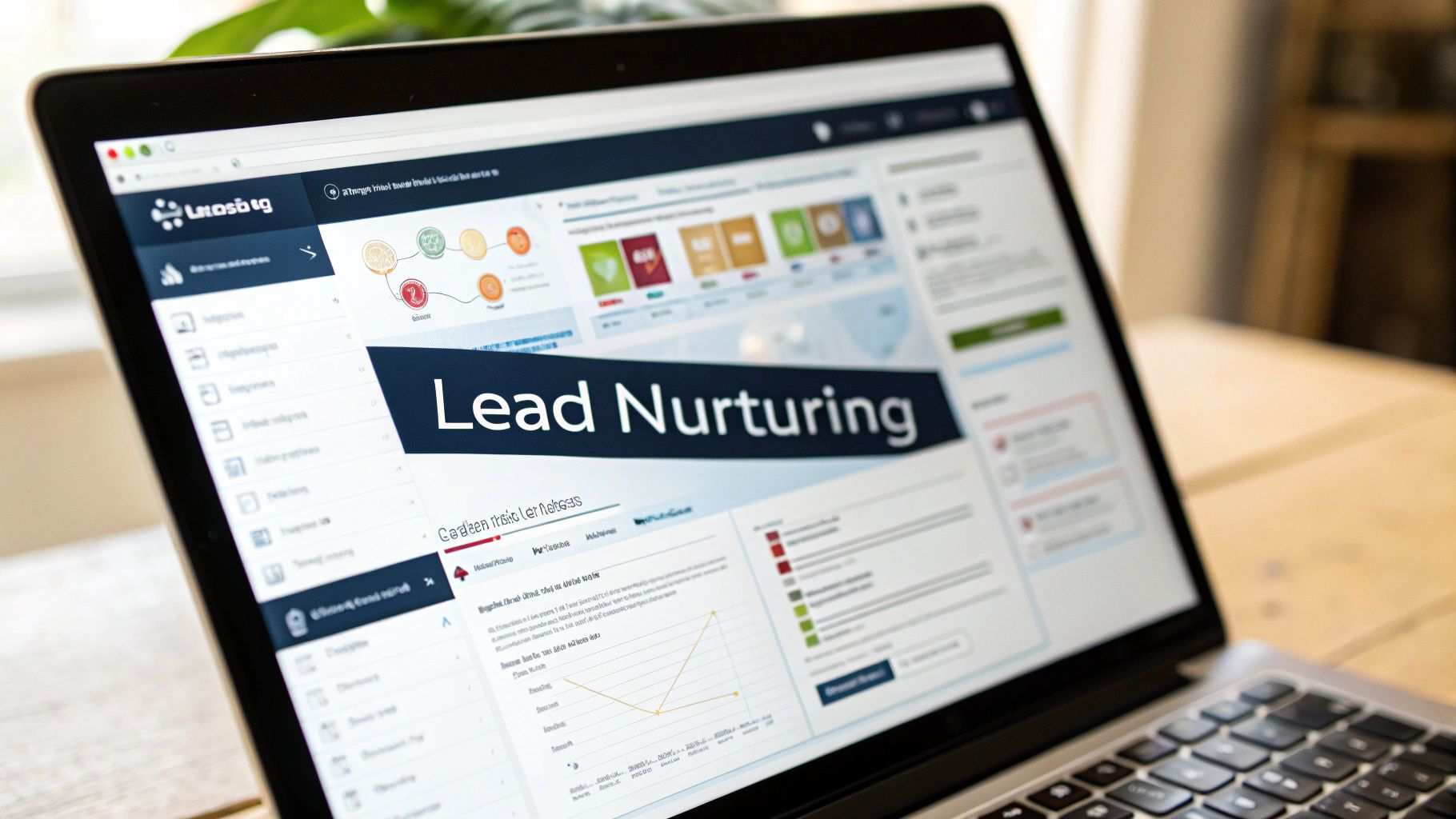
Getting your automated lead generation system up and running is a major win, but the work doesn't stop there. Think of it less like a finished project and more like a high-performance engine. To get the most out of it, it needs constant fine-tuning. This is where AI and a sharp eye on your analytics turn a good system into a great one.
An automated workflow that just runs on its own is a set-it-and-forget-it mistake. It might save you time initially, but it won't adapt to shifting market trends or new customer behaviors. If you commit to a cycle of analyzing and improving, you’ll see your efforts compound, keeping you well ahead of the curve.
Moving Beyond Vanity Metrics
To really get a feel for what’s working, you have to look past the surface-level numbers. Sure, total leads and website traffic are nice to see, but they don't tell the whole story. Real optimization comes from digging into the metrics that directly connect to your pipeline and, ultimately, your revenue.
Focus on the numbers that actually move the needle:
- Stage-by-Stage Conversion Rates: What percentage of your leads actually become Marketing Qualified Leads (MQLs)? And how many of those MQLs get handed off to become Sales Qualified Leads (SQLs)? This is how you find the exact spots where your funnel is leaking.
- Cost Per Qualified Lead (CPQL): Forget the generic Cost Per Lead. Knowing what you spend to get a qualified lead in the door is the true measure of your marketing budget's efficiency.
- Sales Cycle Length: How long does it take for a brand-new lead to sign on the dotted line? Tracking this helps you spot bottlenecks in your process and see how well your nurturing sequences are working.
- Lead Velocity Rate (LVR): This is your month-over-month growth in qualified leads. A strong LVR is one of the best predictors of future revenue growth you can have.
Keep a close watch on these metrics in your CRM or analytics dashboard. A dip in your MQL-to-SQL conversion rate, for instance, is a clear signal that your lead scoring criteria might be off or the handoff to the sales team needs a second look.
Practical Ways to Use AI in Lead Generation
AI isn't some far-off concept anymore; it's a practical tool that can seriously upgrade your optimization game. Today's AI can sift through data, predict outcomes, and automate complex tasks with a precision that was once impossible.
The growth in this area is hard to ignore. The AI market is projected to grow by at least 120% year over year. More importantly, businesses that are actually using AI are seeing real returns—we’re talking revenue bumps of 3% to 15% and sales ROI lifts between 10% and 20%. These aren't just flashy numbers; they show how AI helps marketers focus on the prospects who are most likely to convert.
AI isn’t here to replace your strategy; it’s here to make it smarter. It helps you make better decisions faster by uncovering patterns in your data that you would never find on your own.
Refining Your System with AI-Powered Tools
Bringing AI into your workflow goes beyond just looking at high-level dashboards. It's about using specific tools to sharpen every part of your funnel. To get even more granular with lead qualification, you can look into new tech like LLM-powered call scoring to analyze interactions more effectively.
Here are a few actionable ways to bring AI into your daily operations:
-
Predictive Lead Scoring: Traditional lead scoring relies on fixed rules you set up yourself. Predictive scoring, on the other hand, uses AI to analyze all your past sales data. It figures out the common traits of your best customers and then automatically scores new leads based on that profile. The result is a much more accurate and dynamic system.
-
AI-Powered Chatbots: The chatbots available today are a world away from the clunky bots of the past. They can hold real-time conversations, ask targeted questions to qualify leads on the spot, and even book meetings directly on a sales rep's calendar before seamlessly handing off the conversation to a human.
-
Dynamic Content Personalization: AI allows you to personalize your outreach at scale. It can track a lead’s behavior on your website and then automatically tweak the email content or landing page they see to match their interests. This kind of relevance can dramatically boost engagement and conversion rates.
By pairing smart analytics with the power of AI, you can transform your lead generation system from a static process into a dynamic asset that learns and improves over time. If you’re ready to see which tools can make this happen, our guide on the top AI lead generation software is a great place to start.
Common Questions About Lead Generation Automation
Even with a solid plan in hand, diving into automation can feel a little daunting. It's perfectly normal to wonder about the costs, the complexity, and whether a machine can really replicate that crucial human touch.
Let's clear the air and tackle some of the most frequent questions we hear from businesses taking this step. Getting these answers sorted out will give you the confidence to build and launch your system without looking back.
Marketing Automation vs. Lead Generation Automation
It's easy to get these two mixed up, but they play very different roles. The simplest way to think about it is that marketing automation is the entire orchestra, while lead generation automation is the first violin section—specialized and crucial for starting things off right.
Marketing automation is the big picture. It covers the full customer lifecycle, from the very first touchpoint all the way through to customer retention, upselling, and re-engaging old clients. It's a broad strategy that touches every part of the customer journey.
Lead generation automation, on the other hand, is laser-focused on the top of the sales funnel. Its one job is to attract new prospects, capture their information, and handle the initial qualification. Once a lead is warmed up and ready, it's passed along to the sales team or a wider marketing automation system.
How Much Does It Cost to Automate Lead Generation?
This is always a top-of-mind question, and for good reason. The honest answer is: it really depends on your company's size and how sophisticated you want your system to be. The good news? You don't need a massive enterprise budget to see results.
A small business or a startup can get a surprisingly powerful system up and running for less than $100 per month. This usually involves a smart combination of a few tools:
- An integration platform like Make or Zapier to connect your apps.
- A basic email marketing plan from a service like MailerLite or Mailchimp.
- A simple form builder you can embed on your website.
For a mid-sized company, the investment naturally goes up. Using a full-fledged CRM and marketing platform like HubSpot or Pardot will likely land somewhere between several hundred to a few thousand dollars a month. These tools offer more muscle for things like lead scoring, deep analytics, and complex integrations.
The most important metric isn't the upfront price tag; it's the return on investment (ROI). A well-built system should pay for itself many times over by boosting efficiency, improving lead quality, and ultimately, driving more revenue.
When you're crunching the numbers, don't just look at the monthly subscription. Think about the hours your team will get back by not having to do manual data entry, sift through unqualified leads, or send basic follow-ups. That reclaimed time is a direct financial win from day one.
Can Automation Feel Too Robotic and Impersonal?
This is probably the biggest fear we see, and it's a completely valid one. Let’s be clear: poorly executed automation absolutely feels robotic. It’s generic, irrelevant, and treats every single person the same way.
But great automation does the complete opposite.
The key to avoiding the "robot" trap is hyper-personalization. Modern tools give you the power to use a lead's own data and behavior to create experiences that feel genuinely one-on-one.
Just imagine these scenarios:
- Behavior-Based Triggers: A prospect visits your pricing page twice in one week. Instead of getting another generic newsletter, the system automatically sends a friendly, targeted email from a sales rep offering a personalized demo.
- Dynamic Content: Two people download your new whitepaper. One works in finance, the other in healthcare. Your follow-up emails can automatically feature different case studies and use industry-specific language that speaks directly to each of them.
- Thoughtful Personalization: You can use data points like a lead's first name, company, or even a recent blog post they commented on to craft messages that feel like they were written just for them.
Great automation doesn't replace human connection—it creates more opportunities for it. By taking over the repetitive, top-of-funnel work, it frees up your sales and marketing teams to have more meaningful, strategic conversations with the prospects who are actually engaged and ready to talk. This idea is at the heart of many successful B2B growth strategies, proving that automation can be the key to scaling human connection, not erasing it.
Ready to build an automation engine that saves time and drives revenue? The experts at MakeAutomation specialize in designing and implementing tailored automation frameworks for B2B and SaaS businesses. We'll help you eliminate manual work and build scalable systems for growth. Get your custom automation plan with MakeAutomation today.


